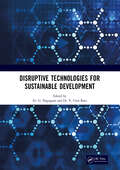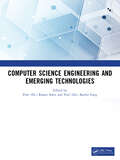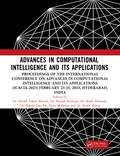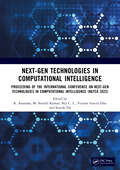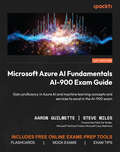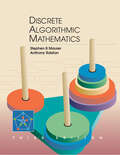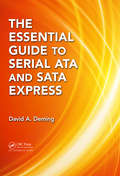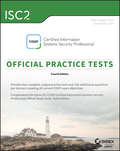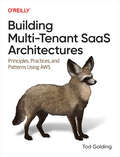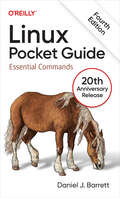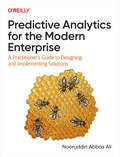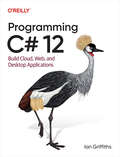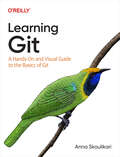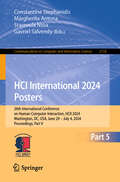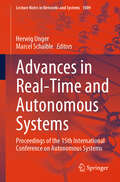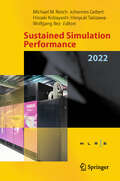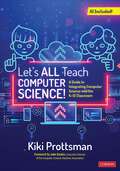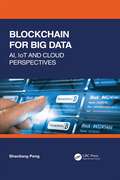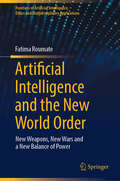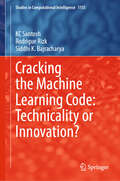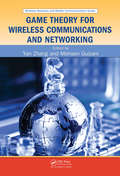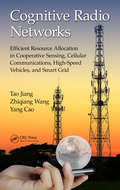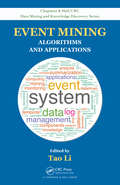- Table View
- List View
Disruptive Technologies for Sustainable Development
by G. Nagappan V. Uma RaniWe feel greatly honoured to have been assigned the job of organizing the AICTE Sponsored International Conference on Application of AI, ML, DL, Big Data on Recent Societal Issues (ICARSI’2023) on April 21 & April 22,2023 at Saveetha Engineering College. The international conference is a platform that brings together the brightest minds from across the globe to share their ideas and insights on the recent societal issues with Artificial intelligence, Machine Learning, Deep Learning, Big data and emerging technologies. With an aim to promote collaboration and foster innovation, this conference promises to be a melting pot of ideas and knowledge sharing.
Computer Science Engineering and Emerging Technologies: Proceedings of ICCS 2022
by Rajeev Sobti Rachit Garg Ajeet Kumar Srivastava Gurpreet Singh ShahiThe year 2022 marks the 100th birth anniversary of Kathleen Hylda Valerie Booth, who wrote the first assembly languageand designed the assembler and auto code for the first computer systems at Birkbeck College, University of London.She helped design three different machines including the ARC (Automatic Relay Calculator), SEC (Simple ElectronicComputer), and APE(X). School of Computer Science and Engineering, under the aegis of Lovely Professional University,pays homage to this great programmer of all times by hosting “BOOTH100”—6th International Conference on ComputingSciences.
Advances in Computational Intelligence and Its Applications
by Sheikh Fahad Ahmad Shadab Siddiqui Rajib Debnath Kakali Das Figlu Mohanty Sumit HazraIt is with great pleasure and enthusiasm that we welcome you to the International Conference on Advances in Computational Intelligence and its Applications (ICACIA-2023). In the ever-evolving landscape of technology, computational intelligence stands as a cornerstone, shaping the future of diverse fields and industries. This conference serves as a nexus for researchers, academicians, and industry experts to converge, exchange ideas, and explore the latest advancements in the realm of computational intelligence.
Next-Gen Technologies in Computational Intelligence: Proceeding of the International Conference on Next-Gen Technologies in Computational Intelligence (NGTCA 2023) (Conference Proceedings Series on Intelligent Systems, Data Engineering, and Optimization)
by M. Senthil Kumar Souvik Pal R. Anandan C. L. Biji Vicente GarcThe Proceeding includes the research contribution from the International Conference on Next-Gen Technologies in Computational Intelligence (NGTCA 2023) held on March 24th 2023 at Vels Institute of Science, Technology and Advanced Studies. NGCTA 2023 is the flagship conference of the Computer Society of India (Region 7). Computer Society of India (CSI) is the largest association of IT professionals in India. CSI is a non-profit organization established in 1965 and its members are committed to the advancement of theory and practice of Computer Engineering and Technology Systems. The Mission of CSI is to facilitate research, knowledge sharing, learning, and career enhancement for all categories of IT professionals, while simultaneously inspiring and nurturing new entrants into the industry and helping them to integrate into the IT community. At present, CSI has 76chapters across India, over 550 student branches with 1,00,000 plus members. It serves its members through technical events, seminars, workshops, conferences, publications & journals, research projects, competitions, special interest groups, awards & recognitions, etc. Various CSI chapters conduct Research Convention every year.
Machine Learning with PyTorch and Scikit-Learn: Develop machine learning and deep learning models with Python
by Sebastian Raschka Vahid Mirjalili Yuxi (Hayden) LiuThis book of the bestselling and widely acclaimed Python Machine Learning series is a comprehensive guide to machine and deep learning using PyTorch s simple to code framework. Purchase of the print or Kindle book includes a free eBook in PDF format.Key FeaturesLearn applied machine learning with a solid foundation in theoryClear, intuitive explanations take you deep into the theory and practice of Python machine learningFully updated and expanded to cover PyTorch, transformers, XGBoost, graph neural networks, and best practicesBook DescriptionMachine Learning with PyTorch and Scikit-Learn is a comprehensive guide to machine learning and deep learning with PyTorch. It acts as both a step-by-step tutorial and a reference you'll keep coming back to as you build your machine learning systems. Packed with clear explanations, visualizations, and examples, the book covers all the essential machine learning techniques in depth. While some books teach you only to follow instructions, with this machine learning book, we teach the principles allowing you to build models and applications for yourself. Why PyTorch? PyTorch is the Pythonic way to learn machine learning, making it easier to learn and simpler to code with. This book explains the essential parts of PyTorch and how to create models using popular libraries, such as PyTorch Lightning and PyTorch Geometric. You will also learn about generative adversarial networks (GANs) for generating new data and training intelligent agents with reinforcement learning. Finally, this new edition is expanded to cover the latest trends in deep learning, including graph neural networks and large-scale transformers used for natural language processing (NLP). This PyTorch book is your companion to machine learning with Python, whether you're a Python developer new to machine learning or want to deepen your knowledge of the latest developments.What you will learnExplore frameworks, models, and techniques for machines to learn from dataUse scikit-learn for machine learning and PyTorch for deep learningTrain machine learning classifiers on images, text, and moreBuild and train neural networks, transformers, and boosting algorithmsDiscover best practices for evaluating and tuning modelsPredict continuous target outcomes using regression analysisDig deeper into textual and social media data using sentiment analysisWho this book is forIf you have a good grasp of Python basics and want to start learning about machine learning and deep learning, then this is the book for you. This is an essential resource written for developers and data scientists who want to create practical machine learning and deep learning applications using scikit-learn and PyTorch. Before you get started with this book, you’ll need a good understanding of calculus, as well as linear algebra.
Microsoft Azure AI Fundamentals AI-900 Exam Guide: Gain proficiency in Azure AI and machine learning concepts and services to excel in the AI-900 exam
by Steve Miles Aaron GuilmetteGet ready to pass the certification exam on your first attempt by gaining actionable insights into AI concepts, ML techniques, and Azure AI services covered in the latest AI-900 exam syllabus from two industry experts Key FeaturesDiscover Azure AI services, including computer vision, Auto ML, NLP, and OpenAIExplore AI use cases, such as image identification, chatbots, and moreWork through 145 practice questions under chapter-end self-assessments and mock examsPurchase of this book unlocks access to web-based exam prep resources, including mock exams, flashcards, and exam tipsBook DescriptionThe AI-900 exam helps you take your first step into an AI-shaped future. Regardless of your technical background, this book will help you test your understanding of the key AI-related topics and tools used to develop AI solutions in Azure cloud. This exam guide focuses on AI workloads, including natural language processing (NLP) and large language models (LLMs). You’ll explore Microsoft’s responsible AI principles like safety and accountability. Then, you’ll cover the basics of machine learning (ML), including classification and deep learning, and learn how to use training and validation datasets with Azure ML. Using Azure AI Vision, face detection, and Video Indexer services, you’ll get up to speed with computer vision-related topics like image classification, object detection, and facial detection. Later chapters cover NLP features such as key phrase extraction, sentiment analysis, and speech processing using Azure AI Language, speech, and translator services. The book also guides you through identifying GenAI models and leveraging Azure OpenAI Service for content generation. At the end of each chapter, you’ll find chapter review questions with answers, provided as an online resource. By the end of this exam guide, you’ll be able to work with AI solutions in Azure and pass the AI-900 exam using the online exam prep resources.What you will learnDiscover various types of artificial intelligence (AI)workloads and services in AzureCover Microsoft's guiding principles for responsible AI development and useUnderstand the fundamental principles of how AI and machine learning workExplore how AI models can recognize content in images and documentsGain insights into the features and use cases for natural language processingExplore the capabilities of generative AI servicesWho this book is forWhether you're a cloud engineer, software developer, an aspiring data scientist, or simply interested in learning AI/ML concepts and capabilities on Azure, this book is for you. The book also serves as a foundation for those looking to attempt more advanced AI and data science-related certification exams (e.g. Microsoft Certified: Azure AI Engineer Associate). Although no experience in data science and software engineering is required, basic knowledge of cloud concepts and client-server applications is assumed.
Discrete Algorithmic Mathematics
by Anthony Ralston Stephen B. MaurerThoroughly revised for a one-semester course, this well-known and highly regarded book is an outstanding text for undergraduate discrete mathematics. It has been updated with new or extended discussions of order notation, generating functions, chaos, aspects of statistics, and computational biology. Written in a lively, clear style, the book is unique in its emphasis on algorithmics and the inductive and recursive paradigms as central mathematical themes. It includes a broad variety of applications, not just to mathematics and computer science, but to natural and social science as well.
The Essential Guide to Serial ATA and SATA Express
by David A. DemingUsed in laptop and desktop computers, low-end servers, and mobile devices, Serial ATA (Advance Technology Attachment), or SATA, is the pervasive disk storage technology in use today. SATA has also penetrated the enterprise computing environment by adding hardware components for fail-over, extending command processing capabilities, and increasing de
ISC2 CISSP Certified Information Systems Security Professional Official Practice Tests (Sybex Study Guide Ser.)
by David Seidl Mike ChappleFull-length practice tests covering all CISSP domains for the ultimate CISSP prep The ISC2 CISSP Official Practice Tests is a major resource for ISC2 Certified Information Systems Security Professional (CISSP) candidates, providing 1300 unique practice questions. The first part of the book provides 100 questions per domain. You also have access to four unique 125-question practice exams to help you master the material. As the only official practice tests endorsed by ISC2, this book gives you the advantage of full and complete preparation. These practice tests align with the 2024 version of the CISSP Detailed Content Outline to ensure up-to-date preparation, and are designed to cover what you will see on exam day. Coverage includes: Security and Risk Management, Asset Security, Security Architecture and Engineering, Communication and Network Security, Identity and Access Management (IAM), Security Assessment and Testing, Security Operations, and Software Development Security. The CISSP credential signifies a body of knowledge and a set of guaranteed skills that put you in demand in the marketplace. This book is your ticket to achieving this prestigious certification, by helping you test what you know against what you need to know. Test your knowledge of the 2024 CISSP domains Identify areas in need of further study Gauge your progress throughout your study and preparation Practice test taking with Sybex’s online test environment containing the questions from the book The CISSP objectives are refreshed every few years to ensure that candidates are up-to-date on the latest security topics and trends. Currently-aligned preparation resources are critical, and periodic practice tests are one of the best ways to truly measure your level of understanding.
Building Multi-Tenant SaaS Architectures: Principles, Practices, And Patterns Using Aws
by Tod GoldingSoftware as a service (SaaS) is on the path to becoming the de facto model for building, delivering, and operating software solutions. Adopting a multi-tenant SaaS model requires builders to take on a broad range of new architecture, implementation, and operational challenges. How data is partitioned, how resources are isolated, how tenants are authenticated, how microservices are built—these are just a few of the many areas that need to be on your radar when you're designing and creating SaaS offerings.In this book, Tod Golding, a global SaaS technical lead at AWS, provides an end-to-end view of the SaaS architectural landscape, outlining the practical techniques, strategies, and patterns that every architect must navigate as part of building a SaaS environment.Describe, classify, and characterize core SaaS patterns and strategiesIdentify the key building blocks, trade-offs, and considerations that will shape the design and implementation of your multi-tenant solutionExamine essential multi-tenant architecture strategies, including tenant isolation, noisy neighbor, data partitioning, onboarding, identity, and multi-tenant DevOpsExplore how multi-tenancy influences the design and implementation of microservicesLearn how multi-tenancy shapes the operational footprint of your SaaS environment
Linux Pocket Guide: Essential Commands
by Daniel J. BarrettIf you use Linux in your day-to-day work, then Linux Pocket Guide is the perfect on-the-job reference. This thoroughly updated 20th anniversary edition explains more than 200 Linux commands, including new commands for file handling, package management, version control, file format conversions, and more.In this concise guide, author Daniel Barrett provides the most useful Linux commands grouped by functionality. Whether you're a novice or an experienced user, this practical book is an ideal reference for the most important Linux commands.You'll learn:Essential concepts—commands, shells, users, and the filesystemFile commands-creating, organizing, manipulating, and processing files of all kindsSysadmin basics-superusers, processes, user management, and software installationFilesystem maintenance-disks, RAID, logical volumes, backups, and moreNetworking commands-working with hosts, network connections, email, and the webGetting stuff done-everything from math to version control to graphics and audio
Predictive Analytics for the Modern Enterprise: A Practitioner's Guide To Designing And Implementing Solutions
by Nooruddin Abbas AliThe surging predictive analytics market is expected to grow from $10.5 billion today to $28 billion by 2026. With the rise in automation across industries, the increase in data-driven decision-making, and the proliferation of IoT devices, predictive analytics has become an operational necessity in today's forward-thinking companies.If you're a data professional, you need to be aligned with your company's business activities more than ever before. This practical book provides the background, tools, and best practices necessary to help you design, implement, and operationalize predictive analytics on-premises or in the cloud. Explore ways that predictive analytics can provide direct input back to your businessUnderstand mathematical tools commonly used in predictive analyticsLearn the development frameworks used in predictive analytics applicationsAppreciate the role of predictive analytics in the machine learning processExamine industry implementations of predictive analyticsBuild, train, and retrain predictive models using Python and TensorFlow
Programming C# 12: Build Cloud, Web, And Desktop Applications
by Ian GriffithsC# is undeniably one of the most versatile programming languages available to engineers today. With this comprehensive guide, you'll learn just how powerful the combination of C# and .NET can be. Author Ian Griffiths guides you through C# 12.0 and .NET 8 fundamentals and techniques for building cloud, web, and desktop applications.Designed for experienced programmers, this book provides many code examples to help you work with the nuts and bolts of C#, such as generics, LINQ, and asynchronous programming features. You'll get up to speed on .NET 8 and the latest C# 11.0 and 12.0 additions, including generic math, new polymorphism options, enhanced pattern matching, and new features designed to improve productivity.This book helps you:Understand how .NET has changed in recent releases and learn what it means for application developmentSelect the appropriate C# language features for any taskLearn when to use the new features and when to stick with older onesExamine the range of functionality in .NET's class librariesApply these class libraries to practical programming tasksExplore numerous small additions to .NET that improve expressiveness
Learning Git: A Hands-on And Visual Guide To The Basics Of Git
by Anna SkoulikariThis book teaches Git in a simple, visual, and tangible manner so that you can build a solid mental model of how Git version control works. Through the use of color, storytelling, and hands-on exercises, you will learn to use this tool with confidence.The information is introduced incrementally so that you don't get bogged down with unknown terms or concepts. Learning Git is ideal for anyone who needs to use Git for personal or professional projects: coding bootcamp students, junior developers, data professionals, and technical writers, to name just a few!This book covers how to:Download Git and initialize a local repositoryAdd files to the staging area and make commitsCreate, switch, and delete branchesMerge and rebase branchesWork with remote repositories including cloning, pushing, pulling, and fetchingUse pull requests to collaborate with others
HCI International 2024 Posters: 26th International Conference on Human-Computer Interaction, HCII 2024, Washington, DC, USA, June 29 – July 4, 2024, Proceedings, Part V (Communications in Computer and Information Science #2118)
by Gavriel Salvendy Margherita Antona Constantine Stephanidis Stavroula NtoaThe seven-volume set CCIS 2114-2120 contains the extended abstracts of the posters presented during the 26th International Conference on Human-Computer Interaction, HCII 2024, held in Washington, DC, USA, during June 29–July 4, 2024. The total of 1271 papers and 309 posters included in the HCII 2024 proceedings were carefully reviewed and selected from 5108 submissions. The posters presented in these seven volumes are organized in the following topical sections: Part I: HCI Design Theories, Methods, Tools and Case Studies; User Experience Evaluation Methods and Case Studies; Emotions in HCI; Human Robot Interaction. Part II: Inclusive Designs and Applications; Aging and Technology. Part III: eXtended Reality and the Metaverse; Interacting with Cultural Heritage, Art and Creativity. Part IV: HCI in Learning and Education; HCI in Games. Part V: HCI in Business and Marketing; HCI in Mobility and Automated Driving; HCI in Psychotherapy and Mental Health. Part VI: Interacting with the Web, Social Media and Digital Services; Interaction in the Museum; HCI in Healthcare. Part VII: AI Algorithms and Tools in HCI; Interacting with Large Language Models and Generative AI; Interacting in Intelligent Environments; HCI in Complex Industrial Environments.
Advances in Real-Time and Autonomous Systems: Proceedings of the 15th International Conference on Autonomous Systems (Lecture Notes in Networks and Systems #1009)
by Herwig Unger Marcel SchaibleThe 15th International conference on "Autonomous Systems" is addressing an important topic for computing systems and communication networks due to increasingly complex environments they are working in. Therefore, this conferences addresses methods and solutions enabling such systems to independently adapt themselves to changed environmental conditions, are able to learn from different sources and to process external requests dependably, safely and timely. The solutions presented here range from hardware to system design to individual applications. The book contains the results of the researchers presented at this conference, which is supported by GI (German Society of informatics) and other organisations Real-Time Systems Expert Committees. The target audience is students and researchers in computer science and automation technology, engineers, programmers and users of automation and communication systems.
Sustained Simulation Performance 2022: Proceedings of the Joint Workshop on Sustained Simulation Performance, High-Performance Computing Center Stuttgart (HLRS), University of Stuttgart and Tohoku University, May and October 2022
by Michael M. Resch Wolfgang Bez Hiroaki Kobayashi Hiroyuki Takizawa Johannes GebertThis book presents the state of the art in High-Performance Computing on modern supercomputer architectures. It addresses trends in hardware and software development in general. The contributions cover a broad range of topics, from performance evaluations in context with power efficiency to Computational Fluid Dynamics and High-Performance Data Analytics. In addition, they explore new topics like the use of High-Performance Computers in the field of Artificial Intelligence and Machine Learning. All contributions are based on selected papers presented in 2022 at the 33rd Workshop on Sustained Simulation Performance, WSSP33, held at HLRS in Stuttgart, Germany, and WSSP34, held at Tohoku University in Sendai, Japan.
Let′s All Teach Computer Science!: A Guide to Integrating Computer Science Into the K-12 Classroom
by Kiki ProttsmanYou belong in this world of computer science education—and because of you, adults of the future will understand how to responsibly participate in high-tech environments with confidence. Districts, cities, and states are moving toward computer science requirements for all K-12 classrooms, even in courses that were not previously associated with technology. These new requirements leave many teachers feeling anxious and unprepared when it comes to integrating computer science into existing curriculum. This book is here to support educators in that shift by inviting them to explore computer science and coding in an approachable and unintimidating way. Let′s All Teach Computer Science: K-12 is a source of inspiration and empowerment for educators who are moving into this technological wonderland. Kiki Prottsman has more than 15 years of experience in computer science education, and her insight informs thoughtful discussions on promoting creativity, problem-solving, and collaboration in students. The book positions computer science in a way that supports other essential skills–such as reading, writing, and mathematics– by providing customizable frameworks that help to seamlessly integrate computer science into core subjects. This book: Provides powerful insights for creating innovative and inclusive learning environments Offers practical examples of integrating computer science into traditional subjects like math, history, art, and more Highlights the importance of addressing implicit biases and promoting computer science as an inclusive field for all students Includes insights on classroom technology and educational technology, as well as AI and its role in education Encourages educators to work together to nurture digital innovators while recognizing potential challenges and frustrations Let′s All Teach Computer Science is an essential guide that equips K-12 teachers with the knowledge and tools necessary to begin teaching computer science immediately–and does so in an enjoyable way, thanks to Prottsman’s friendly and playful style.
Let′s All Teach Computer Science!: A Guide to Integrating Computer Science Into the K-12 Classroom
by Kiki ProttsmanYou belong in this world of computer science education—and because of you, adults of the future will understand how to responsibly participate in high-tech environments with confidence. Districts, cities, and states are moving toward computer science requirements for all K-12 classrooms, even in courses that were not previously associated with technology. These new requirements leave many teachers feeling anxious and unprepared when it comes to integrating computer science into existing curriculum. This book is here to support educators in that shift by inviting them to explore computer science and coding in an approachable and unintimidating way. Let′s All Teach Computer Science: K-12 is a source of inspiration and empowerment for educators who are moving into this technological wonderland. Kiki Prottsman has more than 15 years of experience in computer science education, and her insight informs thoughtful discussions on promoting creativity, problem-solving, and collaboration in students. The book positions computer science in a way that supports other essential skills–such as reading, writing, and mathematics– by providing customizable frameworks that help to seamlessly integrate computer science into core subjects. This book: Provides powerful insights for creating innovative and inclusive learning environments Offers practical examples of integrating computer science into traditional subjects like math, history, art, and more Highlights the importance of addressing implicit biases and promoting computer science as an inclusive field for all students Includes insights on classroom technology and educational technology, as well as AI and its role in education Encourages educators to work together to nurture digital innovators while recognizing potential challenges and frustrations Let′s All Teach Computer Science is an essential guide that equips K-12 teachers with the knowledge and tools necessary to begin teaching computer science immediately–and does so in an enjoyable way, thanks to Prottsman’s friendly and playful style.
Blockchain for Big Data: AI, IoT and Cloud Perspectives
by Shaoliang PengIn recent years, the fast-paced development of social information and networks has led to the explosive growth of data. A variety of big data have emerged, encouraging researchers to make business decisions by analysing this data. However, many challenges remain, especially concerning data security and privacy. Big data security and privacy threats permeate every link of the big data industry chain, such as data production, collection, processing, and sharing, and the causes of risk are complex and interwoven. Blockchain technology has been highly praised and recognised for its decentralised infrastructure, anonymity, security, and other characteristics, and it will change the way we access and share information. In this book, the author demonstrates how blockchain technology can overcome some limitations in big data technology and can promote the development of big data while also helping to overcome security and privacy challenges. The author investigates research into and the application of blockchain technology in the field of big data and assesses the attendant advantages and challenges while discussing the possible future directions of the convergence of blockchain and big data. After mastering concepts and technologies introduced in this work, readers will be able to understand the technical evolution, similarities, and differences between blockchain and big data technology, allowing them to further apply it in their development and research.Author:Shaoliang Peng is the Executive Director and Professor of the College of Computer Science and Electronic Engineering, National Supercomputing Centre of Hunan University, Changsha, China. His research interests are high-performance computing, bioinformatics, big data, AI, and blockchain.
Artificial Intelligence and the New World Order: New weapons, New Wars and a New Balance of Power (Frontiers of Artificial Intelligence, Ethics and Multidisciplinary Applications)
by Fatima RoumateThis book discusses the implications of artificial intelligence (AI) on post-COVID-19 international relations. With the decline and fall of U.S. global leadership and the emergence of new powerful actors, as hastened by the global pandemic, new arms are now used in new forms of wars with new players. The balance of power swings between geostrategic interests and those linked to the global governance of virtual space and the race to technological sovereignty. Chapters focus on the challenges imposed by these changes on different parts of the international system—law, governance, diplomacy, international psychological security—and articulate new strategies and ethical policies as possible solutions. The volume is interdisciplinary and will appeal to researchers, students, and professionals across fields interested in the ethics of AI in the international system.
Cracking the Machine Learning Code: Technicality or Innovation? (Studies in Computational Intelligence #1155)
by KC Santosh Rodrigue Rizk Siddhi K. BajracharyaEmploying off-the-shelf machine learning models is not an innovation. The journey through technicalities and innovation in the machine learning field is ongoing, and we hope this book serves as a compass, guiding the readers through the evolving landscape of artificial intelligence. It typically includes model selection, parameter tuning and optimization, use of pre-trained models and transfer learning, right use of limited data, model interpretability and explainability, feature engineering and autoML robustness and security, and computational cost – efficiency and scalability. Innovation in building machine learning models involves a continuous cycle of exploration, experimentation, and improvement, with a focus on pushing the boundaries of what is achievable while considering ethical implications and real-world applicability. The book is aimed at providing a clear guidance that one should not be limited to building pre-trained models to solve problems using the off-the-self basic building blocks. With primarily three different data types: numerical, textual, and image data, we offer practical applications such as predictive analysis for finance and housing, text mining from media/news, and abnormality screening for medical imaging informatics. To facilitate comprehension and reproducibility, authors offer GitHub source code encompassing fundamental components and advanced machine learning tools.
Game Theory for Wireless Communications and Networking (Wireless Networks And Mobile Communications Ser.)
by Yan Zhang Mohsen GuizaniThis comprehensive technical guide explains game theory basics, architectures, protocols, security, models, open research issues, and cutting-edge advances and applications. Describing how to employ game theory in infrastructure-based wireless networks and multihop networks to reduce power consumption, it facilitates quick and easy reference to related optimization and algorithm methodologies. The book explains how to apply the game theoretic model to address resource allocation, congestion control, attacks, routing, energy management, packet forwarding, and MAC.
Cognitive Radio Networks: Efficient Resource Allocation in Cooperative Sensing, Cellular Communications, High-Speed Vehicles, and Smart Grid
by Tao Jiang Yang Cao Zhiqiang WangResource allocation is an important issue in wireless communication networks. In recent decades, cognitive radio-based networks have garnered increased attention and have been well studied to overcome the problem of spectrum scarcity in future wireless communication systems. Many new challenges in resource allocation appear in cognitive radio-based networks. This book focuses on effective resource allocation solutions in several important cognitive radio-based networks, including opportunistic spectrum access networks, cooperative sensing networks, cellular networks, high-speed vehicle networks, and smart grids.
Event Mining: Algorithms and Applications (Chapman & Hall/CRC Data Mining and Knowledge Discovery Series #38)
by Tao LiWith a focus on computing system management, this book presents a variety of event mining approaches for improving the quality and efficiency of IT service and system management. It covers different components in the data-driven framework, from system monitoring and event generation to pattern discovery and summarization. The book explores recent developments in event mining, such as new clustering-based approaches, as well as various applications of event mining, including social media.
